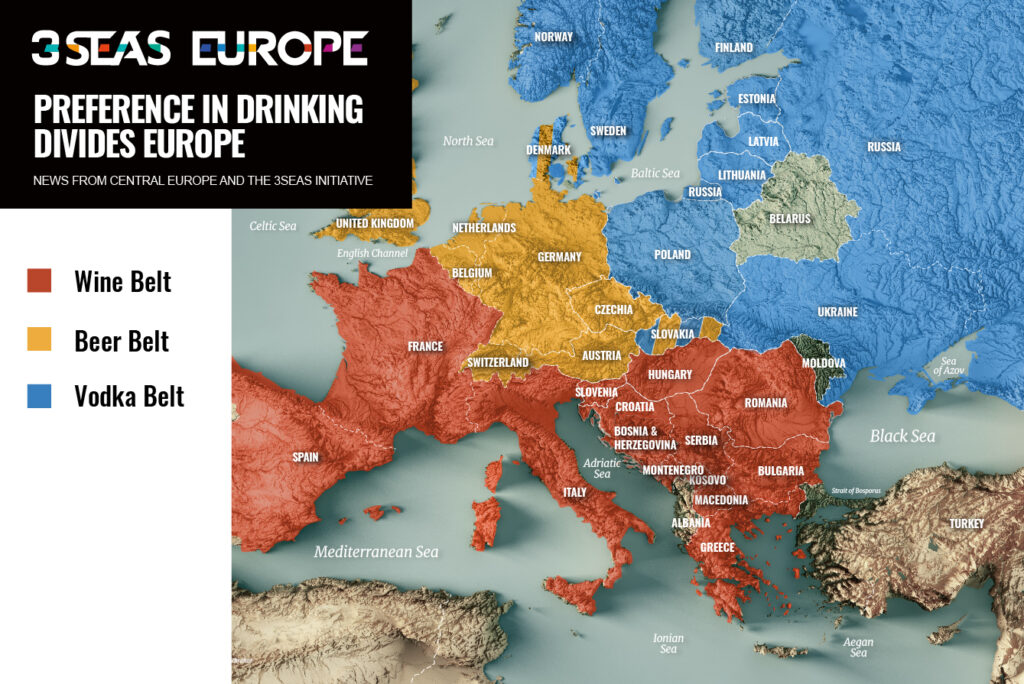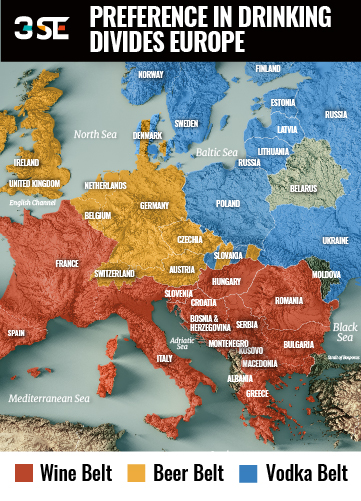When Yanko Tsvetkov, a Spain-based Bulgarian artist, published a sequel to his “Atlas of Prejudice” in 2014, the concept was already established that Europe could be divided into three parts: the wine drinkers, the vodka enthusiasts, and the beer belt, which sits in between. Maybe one can trace its origins to “geoalcoholics” – a term coined by Russia-expert Alex de Jonge in the 1986 book “Stalin and the Shaping of the Soviet Union.”
In the “Atlas of Prejudice,” the map (nr 6) takes the form of a “beer wedge” – a sharp triangle inserted between wine and vodka, with vodka reigning supreme in the north, wine along the south, and beer ruling the triangle in the center, encompassing the British Isles and most of Germany. Central Europe is the natural location to look for the tripoint of the regional borders, as it has been in real historical frontiers, such as the Three Emperors’ Corner.
Vodka belt in Europe?
It all makes sense. When you take stereotypes and simplifications into consideration, you can actually feel the warmth of the wine-drinking joie de vivre of, say, Bulgaria, Croatia, or Romania with their beach resorts. You can also feel the freezing days in Latvia or Estonia calling for a quick shot of a strong spirit. And you can sense the idea of joyful community in beer-bingeing Prague.
But although it’s easy to associate different countries with different consumption styles and alcohols of choice, actual lines tend to be blurrier. Case in point: Austria, Czechia, and Slovakia. The two formers are classically, almost eponymously, beer-drinking lands but – perhaps to some surprise – strong in producing delicious wine. The blur in Slovakia is of another kind. It is somewhat hard to declare it as either a vodka or beer country. And what about Latvia, where recently cider takes over?
Things get much more complicated when we stop thinking in terms of abstract “modes of consumption.” The recorded per capita consumption shows that Central Europe is a land of beer. In 2016, even Russia was slowly taken over by lightly alcoholic drinks. “Traditional” vodka countries such as those in the Baltic and Poland are already beer countries.
European wine
The same is true for the “wine region” of the east: Romania, Hungary or Croatia have a preference in beer, while Bulgaria switched wine to vodka. For countries outside of Central Europe, in a shocking turn Spain and Sweden have switched places, with the latter being a wine-loving island in a sea of beer and the former – just the opposite.
This “expectations vs. reality” difference may seem unexpected when looking in from the outside. But what’s important to understand is that Central Europe is an area of constant change in terms of social politics, cultural shifts, and modernizing processes. That said, it’s no sin to look for cultural paradigms. But why look for them at the bottom of a glass?









